With most modern audiovisual content being produced using smartphones, many people have yet to understand the benefits of upgrading to a proper video camera. However, the price of most high-level professional video cameras can be a discouraging factor to many. Today we will look at the top 10 best cameras for video under $1000 and what makes them stand out.
I’ve picked the Panasonic Lumix G85 for the number one spot on this list. With its fantastic autofocus system, sharp and detailed 4K recording capabilities, and outstanding image stabilization, it is the best video camera for low-budget filmmaking and video production.
If you are looking for the best video camera that doesn’t break the bank, you’ve come to the right place. It doesn’t matter if you’re a hobbyist, vlogger, or cinematographer. This list has got you covered.
Without further ado, let’s get right into it.
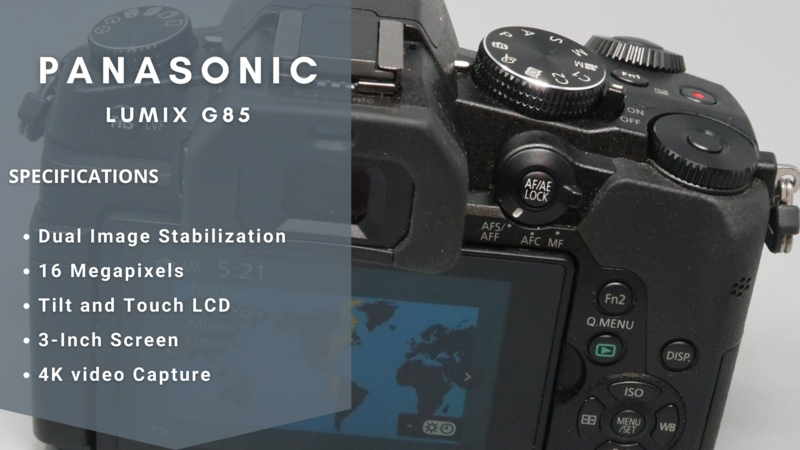
Stefan’s take:
Handling it for the first time, I was really impressed by what this video camera has to offer.
Its superb professional setting capabilities truly make it the best camera for video under $1000.
One of the most remarkable things I noticed is that it has an amazing high ISO-value performance and improved dynamic range.
I also really enjoyed the improved autofocus system of this Panasonic model. In addition, its wireless feature allowed me to control the camera remotely.
The Lumix G85 is definitely the best mirrorless camera on this list.
Who is it best for:
Filmmakers looking for the most affordable camera for professional work.
It is an ideal choice for those looking to produce high-quality 4K video footage on a budget.
Key Features:
The Lumix G85 is an excellent mid-range video camera with plenty of high-end features.
Its 2nd-generation 5-axis image stabilizing system makes the Lumix G85 very resilient to camera shake, an important point for filmmaking.
This camera is characterized by a 16-megapixel sensor, amazing autofocus, and a 3-inch touchscreen LCD, all packed into a moister and dust-resilient body.
It is capable of capturing 4K video material at 30 frames per second, making it a very versatile sub-one-thousand dollar choice compared to other cameras in the price range.
Pros:
- Power-saving mode
- Outstanding image stabilizing system
- Great autofocus
Cons:
- Short battery life
- Electronic viewfinder
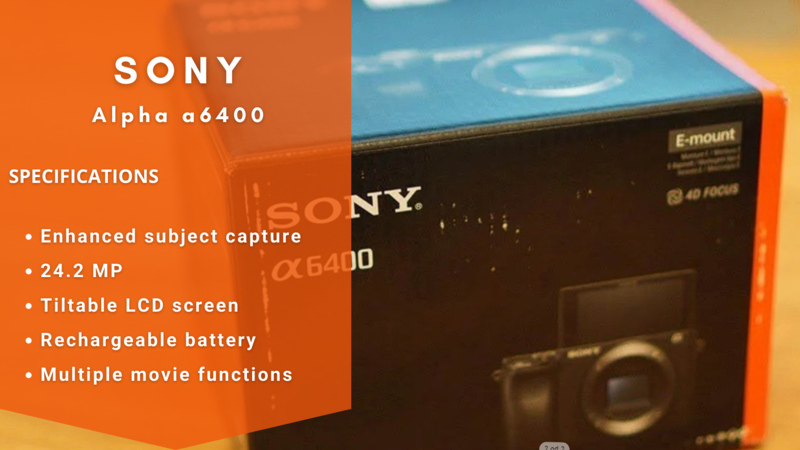
Stefan’s take:
The Sony a6400 was one of the first video cameras in the price range of up to $1000 that caught my attention. The very first thing I noticed with this model is how lightweight the body is. Its compact construction makes it easy to handle and even easier to carry.
I particularly like the built-in 180-degree LCD screen. It allows for versatility in video recording, photography, and vlogging.
Who is it best for:
If you are a fan of Sony video cameras, this model is an ideal option.
Its lightweight construction and supreme picture quality make it a dream for vloggers and content creators
Key Features:
As the official successor to the a6300 model, it features the same 24-MP APS-C sensor, with many added features and capabilities. The APS-C format offers a nice balance of size, picture quality, and control over the field of depth.
With a whopping resolution of 24 megapixels, this Sony model is great for both 4K video capture and photography.
Equipped with a mirrorless interchangeable lens, it offers a real-time eye auto-focus system ideal for vlogging.
One of my personal favorite features of the a6400 is the 11 frames-per-second burst shooting mode. I’ve found that this feature can be extremely effective at capturing moving subjects.
In summary, I’d say the Sony a6400 is undoubtedly the best Sony camera on this list, and one of the best cameras in this price range, period.
Pros:
- Great auto-focus system
- 4K video recording
- Excellent image quality
- Tiltable LCD screen
Cons:
- Limited options for external control

Stefan’s take:
The Olympus OM-D E-M10 Mark III is a versatile, high-quality mirrorless camera.
One of my favorite things about this Olympus model is its vintage design.
Being a mirrorless camera, it is a lot lighter than DSLR cameras. I’ve found it to be particularly useful for producing outdoor cinematic video content.
I absolutely love the face/eye priority AF feature introduced in this model. It makes for a great point-and-shoot camera.
Who is it best for:
For beginner cinematographers in need of a compact, easy-to-use solution, the Olympus OM-D E-M10 Mark III is one of the best video cameras on the market.
Easy to pack, with an average battery life of 330 shots per charge, the Mark III is a great video camera for both professional video and content creation.
Key Features:
This camera has a micro four-thirds sensor with a resolution of 16 megapixels. 5-axis image stabilization, and a TruePic VIII processor.
One of its most notable features is its incredibly quick and accurate 121-point AF system that covers a wide focus area allowing for a very fast workflow.
The tiltable LCD screen makes the Mark III very easy to use with just one hand and allows effortless execution of shots with a challenging perspective.
Even though it has only 16 megapixels, it offers a very impressive quality of image. Working with the Mark III, I’ve noticed very few noise artifacts, even at higher ISO values.
Another amazing feature is the autofocus shutter mode. Tap your subject on the LCD screen, and it will automatically adjust the focus. Truly a great video camera.
Pros:
- Very affordable camera
- Silent shot mode
- Optical image stabilization
- Video mode
Cons:
- No external mic port
- Sub-20-megapixel camera sensor

Stefan’s take:
The D5600 is one of the older video cameras on this list.
I picked this camera up with the intent of testing its video shooting capabilities, and, boy, did it deliver.
The video shooting sessions were extremely productive, the video footage was captured superbly, and the workflow was very efficient.
For a mid-level budget camera, the Nikon D5600 is a powerhouse.
Who is it best for:
Great for newbie videographers in need of a budget video camera, or vloggers looking to upgrade.
If you are a novice looking to shoot videos, the D5600 is one of the best cameras to start with.
Key Features:
The D5600 features a 24-megapixel DX-format CMOS sensor, EXPEED 4 image processor, and a vari-angle touchscreen.
It is capable of producing high-quality videos with a variety of different settings to make the job a lot easier.
With a shutter speed range of 1/4,000 seconds to 30 seconds, a live view autofocus system, and a time-lapse movie recording mode, you can see why the D5600 is considered a cheap camera in terms of its price-to-value ratio.
It is possibly the best DSLR camera in this price range for producing awesome videos.
Pros:
- Compact body
- Very long battery life
- Produces great images
Cons:
- Few external controls
- Not the best for studio

Stefan’s take:
The Nikon D7500 has seen some humble improvements when compared to its predecessors.
I’m very fond of the crisp detail and vibrant colors it produces in its images. The dynamic range is also very good.
Working in low-lighting settings, I’ve taken quite a liking to its performance with a high-ISO value.
The Wi-Fi and Bluetooth features have also allowed me greater control over the camera and increased my workflow efficiency.
Who is it best for:
A great choice for urban videography
The improved sensor and processing technology give the images an artistic sense of detail, and the high-ISO performance makes for great night-time video sessions.
Key Features:
The D7500 is mounted with a 20.9-megapixel APS-C CMOS sensor.
In addition to that, it has a 51-point phase-detect autofocus system and a burst capability of 8 frames-per-second for 50 raw images.
The tilting touchscreen LCD is great for making quick changes in the camera settings, all build into a weather-sealed body.
This camera also shoots 4K video, though with a 1.7x crop.
Good ISO performance and dynamic range make it one of the best DSLR cameras in the price range of under $1000.
Pros:
- Detailed image
- 4K video
- Great continuous shooting
Cons:
- Cropped 4K
- One card slot
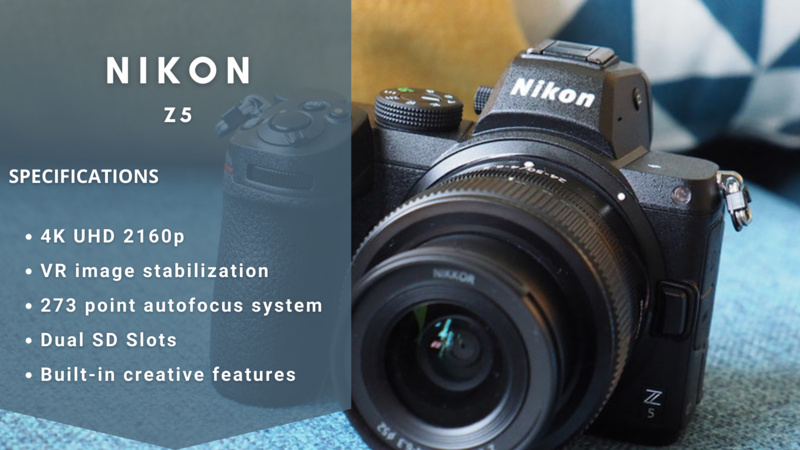
Stefan’s take:
I have had the privilege of working with the Nikon Z5, as well as the Z6 and Z7. With this experience in mind, I’d say that the Z5 is more similar to its higher-end counterparts than it is different.
Standing in the higher end of the $1000 price range, the Z5 is a strong contender compared to other video cameras on this list.
Personally, I think the Z5 is an extremely versatile camera, well worth the price it sits on.
Throughout my experience with this mirrorless camera model, I’ve found that it is exceptionally useful when capturing moving subjects
Who is it best for:
For those looking to obtain professional-quality images on a budget, the Z5 is one of the best mirrorless cameras currently on the market.
This includes both professional videographers and videography enthusiasts.
Key Features:
With a myriad of advanced features, it’s hard to know where to begin talking about the Z5.
This full-frame mirrorless camera uses a stabilized non-BSI 24-megapixel CMOS sensor. It is equipped with a 273-point hybrid autofocus system, EXPEED 6 image processing, and a 3.69M-dot OLED viewfinder.
With an ISO range of 100 to 51,600 and a 5-axis in-body image stabilization system, the Z5 is surely a strong contender in the realm of full-frame mirrorless cameras.
In terms of video quality, this camera lacks slightly behind its higher-end siblings. It offers 4K video recording with 1.7x crop, and full HD video quality without any crop.
Additionally, the Z5 has a light body construction with the added benefit of dust and moisture resilience.
A great camera, all things considered.
Pros:
- Extremely versatile
- Great autofocus
- Compact camera body
Cons:
- Not beginner-friendly
- Heavily cropped 4K
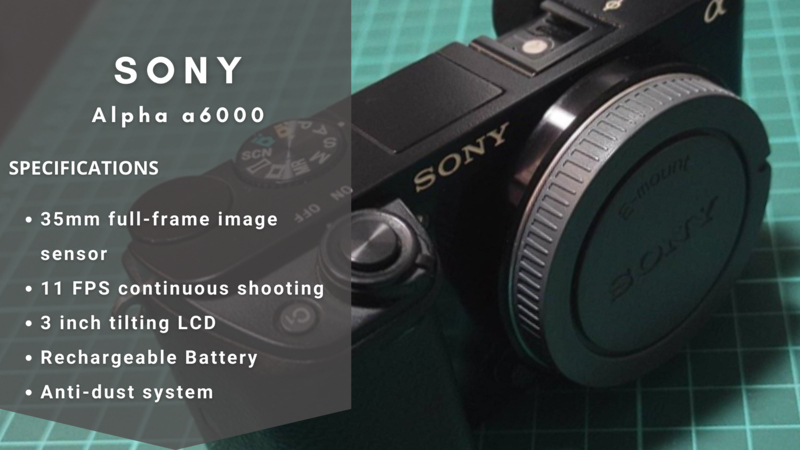
Stefan’s take:
This Sony camera model is one of the more affordable mirrorless cameras currently on the market.
One of the things that stood out to me the most is its hybrid autofocus system that uses 179 phase-detection and 25 contrast-detection points.
Additionally, I was quite pleased with its above-average 420-shot battery life
Though not the best Sony camera on this list, the pros of the a6000 far outweigh the cons.
Who is it best for:
Hobbyists looking to buy an entry-level camera with good battery life. It’s great for taking photos and recording video.
If you are interested in upgrading from using smartphone cameras for your videography, the a6000 is a great place to start.
Key Features:
This Sony camera is compatible with a wide range of Sony lenses, allowing users variety in their creative choices.
It is equipped with a 24-megapixel APS-C CMOS sensor, Bionz X image processor, and a decent built-in OLED electronic viewfinder.
One of the more impressive features of this Sony camera is the 11 frames-per-second continuous shooting mode made even better with the subject-tracking feature. Bye-bye blurry images!
The a6000 also has a tiltable LCD screen, making your videography endeavors much easier.
Lastly, the maximum video resolution this camera offers is Full HD. Not exactly a high-end videography camera, but its video capabilities are still very good.
Pros:
- Wide lens selection
- Great autofocus system
- Very durable
Cons:
- Lacks touchscreen
- Difficult AF settings
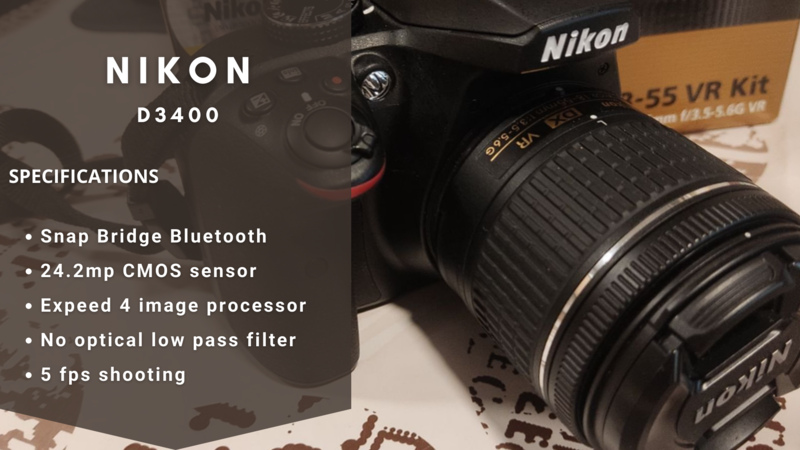
Stefan’s take:
Sitting at the tail-end of Nikon’s price range, the D3400 has one of the best price-to-value ratios I have ever seen.
It is comfortable, ergonomic, and also surprisingly light compared to most cameras in my collection. I’ve also found its interface to be very easy to use.
I wouldn’t say it’s the best video camera choice for a professional setting, though. The D3400 is more suited for casual recording in the everyday.
Who is it best for:
This video camera model is undeniably designed for beginners and hobbyists. Even Nikon has labeled it as entry-level.
It is a convenient choice for traveling and family videos.
Key Features:
The Nikon D3400 offers a beginner-friendly, easy-to-use interface, even including a beginner guide mode.
Being the improved version of the D3300, it is equipped with the same 24-megapixel APS-C CMOS sensor.
Capable of delivering detail-rich images, this camera possesses a humble ISO range of 100 to 25,600, a fantastic 11-point autofocus system, and a 5-frames-per-second continuous shooting speed.
As a low-end DSLR camera, it isn’t practically designed for video recording. Full HD video quality is the best it can offer.
One of the more convenient features of the D3400 is Bluetooth connectivity. Connecting your camera to your smartphone via Bluetooth grants you greater control when shooting remote videos.
Pros:
- Amazing autofocus
- Compact camera build
- Has a beginner guide mode
Cons:
- Low-end
- Full HD max video resolution
- No external mic port

Stefan’s take:
Another good Nikon video camera model for under $1000. In my personal opinion, the Nikon Z50 can easily compete with most entry-level DSLR video cameras out there.
I was pleasantly surprised to find out that this compact video camera offers supreme image quality at both ends of its ISO range
Its lightweight body and compact construction make it very wieldy and convenient for both photography and recording videos.
Who is it best for:
The Z50 might not be the best video camera for filmmaking in this price range, but it is one of the best cameras for vloggers and content creators.
Designed by Nikon to attract new users, its features provide for a very forgiving, beginner-friendly workflow.
Key Features:
Equipped with a 20.9-megapixel APS-C sensor, the Z50 is a first-generation Z-mount DX mirrorless camera, designed to produce professional-level image quality, as well as high-quality video material.
In addition to recording high-quality 4K video content at up to 30 frames per second, this camera also offers a slow-motion recording mode in Full HD (at up to 120 fps).
A variety of different Z-mount lenses were launched with the camera. Having a variety of lens options to choose from has allowed me the option to keep my digital camera kit small and versatile.
I’ll also add that along with its impressive ISO range (100 to 51,200), the Z50 camera also features a fast phase-detection AF system. While it might not be the best mirrorless camera on this list, I highly recommend taking it into consideration.
Pros:
- 11 frames-per-second continuous shooting
- Compact kit lens
- Bluetooth enabled Wi-Fi
Cons:
- Lacks control
- AF point can’t be set on the screen

Stefan’s take:
One of my favorite things about the Rebel T8i is the optical viewfinder. Canons optical viewfinders offer a much better resolution than the electronic viewfinders many cameras use.
I’m also very fond of the built-in vari-angle touchscreen. I’ve personally used it in nature photography to get those awkwardly-angled shots.
While the Rebel T8i is a good camera, all things considered, I wouldn’t put it at the top of the list. Don’t get me wrong, it can be a solid choice for certain types of video material. However, it can’t compare to some of its mirrorless counterparts.
Who is it best for:
The Rebel T8i is a solid option for those just getting into photography and looking to make an upgrade from using their phone cameras.
Additionally, it has also proved to be convenient for landscape videography.
Key Features:
Clocking in at an impressive 24 megapixels, this camera body is compatible with Canons EF and EF-S mount lenses. For those looking to capture vibrant images in great detail, the T8i will get the job done.
In terms of its video capabilities, I can’t say I’m impressed. While the T8i is capable of video recording in 4K, the video quality is not up to par with other mirrorless options in this price range.
One thing that I do like is the consistency of image quality across the ISO range. Even if you find yourself shooting at a higher ISO due to poor lighting conditions, your image won’t suffer from too much graininess.
Overall, the T8i is not the best video camera in this price range, but it isn’t bad either.
Pros:
- Good image quality
- Great AF system for photography
- Optical viewfinder
Cons:
- No phase-detection AF
- Mediocre stabilization
- Cropped 4K video
- No dual-pixel AF
Conclusion
Videography is for everyone, and you don’t need to spend thousands of dollars on a professional video camera just to get started. There are a ton of good options for every price range to take your video content to the next level.
In my experience, these are the best video cameras for under a thousand dollars:
- Panasonic Lumix G85 – the best for filmmakers
- Sony a6400 – the best for vloggers and content creators
- Olympus OM-D E-M10 Mark III – the best for beginner videographers
I hope that this article has helped you find the best video camera for your needs, and will motivate you to indulge in the art of video production much more frequently.

